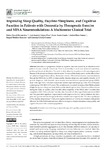Mostrar o rexistro simple do ítem
Improving sleep quality, daytime sleepiness, and cognitive function in patients with dementia by therapeutic exercise and NESA neuromodulation: a multicenter clinical trial
| dc.contributor.author | Teruel-Hernández, Esther | |
| dc.contributor.author | López-Pina, José Antonio | |
| dc.contributor.author | Souto-Camba, Sonia | |
| dc.contributor.author | Báez-Suárez, Aníbal | |
| dc.contributor.author | Medina-Ramírez, Raquel | |
| dc.contributor.author | Gómez-Conesa, Antonia | |
| dc.date.accessioned | 2023-11-15T06:51:25Z | |
| dc.date.available | 2023-11-15T06:51:25Z | |
| dc.date.issued | 2023-11-06 | |
| dc.identifier.citation | Teruel-Hernández E, López-Pina JA, Souto-Camba S, Báez-Suárez A, Medina-Ramírez R, Gómez-Conesa A. Improving sleep quality, daytime sleepiness, and cognitive function in patients with dementia by therapeutic exercise and NESA neuromodulation: a multicenter clinical trial. Int J Environ Res Public Health. 2023 Nov 6;20(21):7027. | es_ES |
| dc.identifier.issn | 1660-4601 | |
| dc.identifier.uri | http://hdl.handle.net/2183/34218 | |
| dc.description | Multicenter study | es_ES |
| dc.description.abstract | [Abstract] Dementia is a progressive decline in cognitive functions caused by an alteration in the pattern of neural network connections. There is an inability to create new neuronal connections, producing behavioral disorders. The most evident alteration in patients with neurodegenerative diseases is the alteration of sleep-wake behavior. The aim of this study was to test the effect of two non-pharmacological interventions, therapeutic exercise (TE) and non-invasive neuromodulation through the NESA device (NN) on sleep quality, daytime sleepiness, and cognitive function of 30 patients diagnosed with dementia (non-invasive neuromodulation experimental group (NNG): mean ± SD, age: 71.6 ± 7.43 years; therapeutic exercise experimental group (TEG) 75.2 ± 8.63 years; control group (CG) 80.9 ± 4.53 years). The variables were evaluated by means of the Pittsburg Index (PSQI), the Epworth Sleepiness Scale (ESS), and the Mini-Cognitive Exam Test at four different times during the study: at baseline, after 2 months (after completion of the NNG), after 5 months (after completion of the TEG), and after 7 months (after 2 months of follow-up). Participants in the NNG and TEG presented significant improvements with respect to the CG, and in addition, the NNG generated greater relevant changes in the three variables with respect to the TEG (sleep quality (p = 0.972), daytime sleepiness (p = 0.026), and cognitive function (p = 0.127)). In conclusion, with greater effects in the NNG, both treatments were effective to improve daytime sleepiness, sleep quality, and cognitive function in the dementia population. | es_ES |
| dc.language.iso | eng | es_ES |
| dc.publisher | MDPI | es_ES |
| dc.relation.uri | https://doi.org/10.3390/ijerph20217027 | es_ES |
| dc.rights | Creative Commons Attribution 4.0 International License (CC-BY 4.0) | es_ES |
| dc.rights.uri | http://creativecommons.org/licenses/by/4.0/ | * |
| dc.subject | Dementia | es_ES |
| dc.subject | Neuromodulation | es_ES |
| dc.subject | New technologies | es_ES |
| dc.subject | Physical activities | es_ES |
| dc.subject | Physiotherapy | es_ES |
| dc.subject | Sleep quality | es_ES |
| dc.title | Improving sleep quality, daytime sleepiness, and cognitive function in patients with dementia by therapeutic exercise and NESA neuromodulation: a multicenter clinical trial | es_ES |
| dc.type | info:eu-repo/semantics/article | es_ES |
| dc.rights.access | info:eu-repo/semantics/openAccess | es_ES |
| UDC.journalTitle | International Journal of Environmental Research and Public Health | es_ES |
| UDC.volume | 20 | es_ES |
| UDC.issue | 21 | es_ES |
Ficheiros no ítem
Este ítem aparece na(s) seguinte(s) colección(s)
-
GI-IPRF - Artigos [137]






